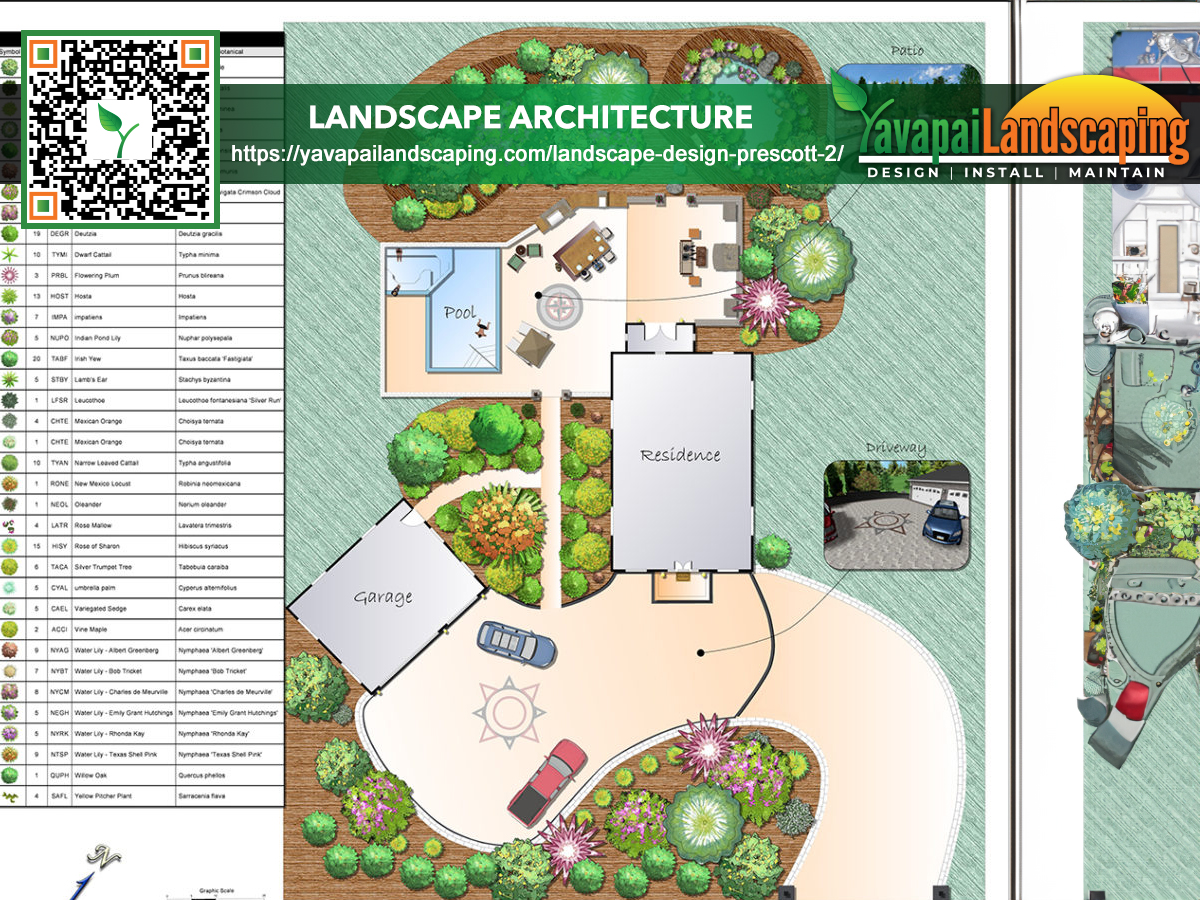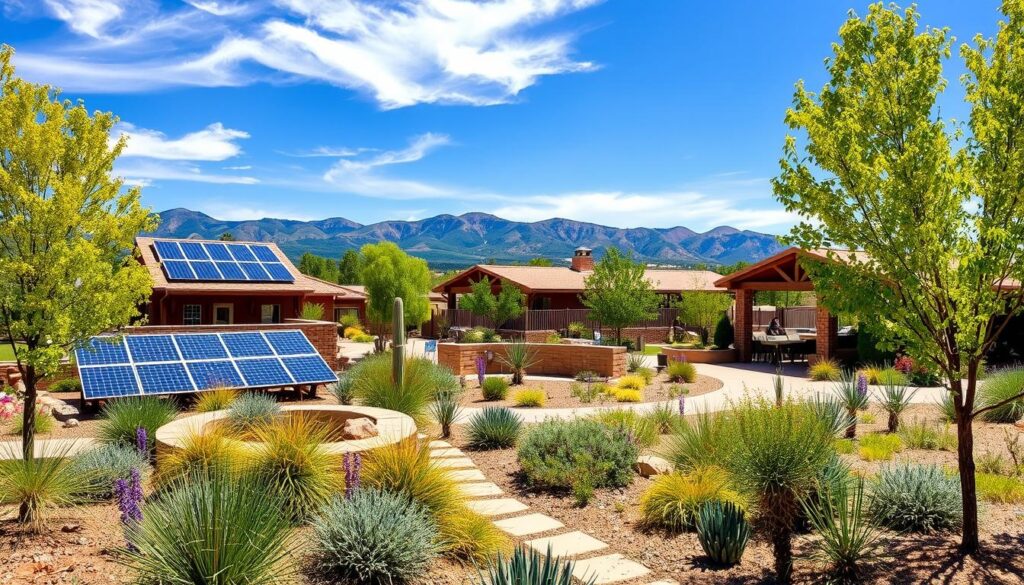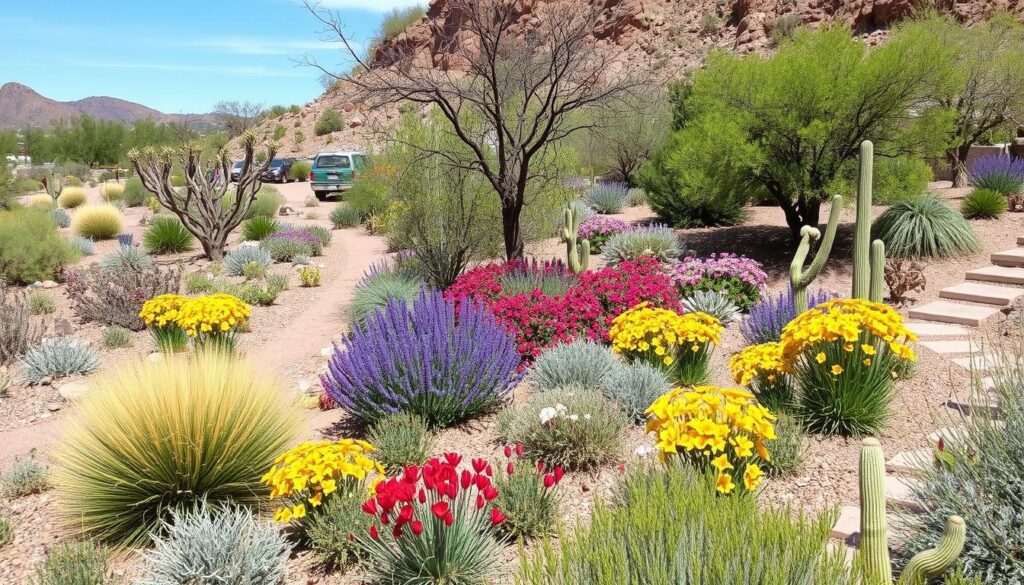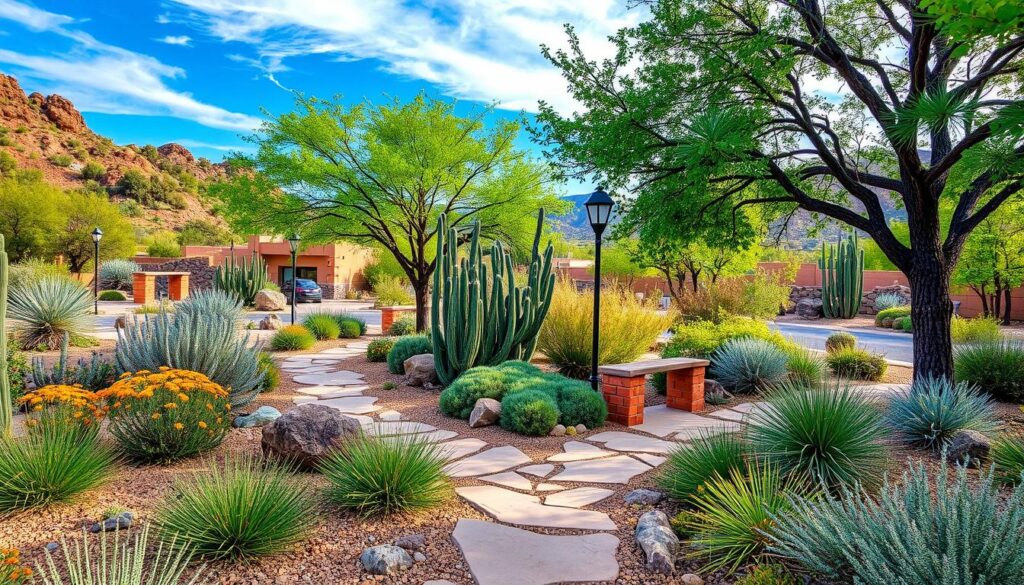
Landscape architecture is key in promoting environmental care. It designs outdoor spaces that blend with nature, save resources, and help wildlife. In Prescott, Arizona, architects face challenges like the dry climate and growing cities. They use green designs and native plants and save water to make landscapes that are both beautiful and kind to the environment.
Green solutions like rain gardens and permeable pavements manage stormwater. They improve water quality and help recharge groundwater. These features make cities more sustainable and resilient.
By saving and restoring native habitats, architects help wildlife and keep ecosystems healthy. This also helps people learn about nature and connect with it.
Key Takeaways:
- Landscape architecture promotes environmental stewardship through sustainable design practices.
- Prescott, AZ faces unique ecological challenges due to its arid climate and urban development pressures.
- Utilizing native plants and water conservation techniques creates resilient and ecologically responsible landscapes.
- Green infrastructure solutions help manage stormwater runoff and improve water quality.
- Preserving native habitats supports biodiversity and fosters a connection between people and nature.
Understanding the Role of Landscape Architecture in Environmental Stewardship

Landscape architecture is key to protecting our environment and promoting sustainable living. Landscape architects use nature-friendly designs to create green spaces. These spaces improve our surroundings and meet human needs.
It’s important to understand the role of landscape architecture. This field helps us care for our environment through design.
Defining Landscape Architecture and Its Scope
Landscape architecture is a mix of art, science, and technology. It deals with designing outdoor spaces like parks and gardens. The goal is to make these spaces beautiful, useful, and good for the environment.
This field goes beyond just making things look nice. It’s about blending human activities with nature. This way, spaces are both sustainable and meet the needs of people and nature.
The Importance of Environmental Stewardship in Landscape Design

Environmental stewardship is at the heart of landscape architecture. It aims to create landscapes that are good for the planet. Landscape architects design spaces that support both humans and nature.
They focus on making spaces that are healthy and strong. This includes using plants that are native to the area and managing water wisely. Their work helps reduce pollution and supports wildlife.
- Reduce the urban heat island effect by integrating green spaces and tree canopy cover
- Improve air and water quality through the use of native plant species and sustainable stormwater management techniques
- Provide habitats for wildlife and promote biodiversity in urban and suburban settings
- Encourage sustainable development practices that minimize resource consumption and waste generation
By focusing on environmental care, landscape architects help build better communities. They use design to fight climate change and urban growth. Their work ensures a sustainable future for all. Don’t miss out on this enlightening article.
Prescott AZ’s Unique Ecological Challenges and Opportunities
Prescott, Arizona’s landscape design, faces unique challenges due to its location. The high desert of central Arizona offers both hurdles and chances for green spaces. This makes it crucial for effective environmental care.
Climate and Geographical Considerations
Prescott, AZ, has a semi-arid climate with hot summers and mild winters. It also gets a little rain. Designers must focus on saving water and choosing plants that can handle dry conditions.
The city’s height and shape also play a part in planning. They need to think about soil, water flow, and preventing soil erosion.
Native Flora and Fauna in Prescott AZ
The area is rich in native plants and animals. This includes:
- Ponderosa pine forests
- Chaparral shrublands
- Riparian habitats along the Verde River and its tributaries
Using native species in designs adds beauty and supports local wildlife. It also cuts down on the need for a lot of upkeep.
Balancing Urban Development and Ecological Preservation
As Prescott grows, landscape architects are key in finding a balance. They use green practices and protect key ecological spots. This helps lessen the city’s impact on nature.
They work with city planners and developers. Together, they aim to blend buildings with the natural world smoothly.
Sustainable Landscape Design Strategies for Prescott AZ

Landscape architects in Prescott, AZ, must use sustainable design to care for the environment. They do this by using low-water landscaping and drought-tolerant plants. This helps save water while keeping outdoor spaces beautiful.
They also focus on managing stormwater runoff and improving water quality. Permeable paving and green infrastructure like rain gardens help. These elements reduce erosion, filter pollutants, and recharge groundwater.
Another key part is passive solar design. Designers place trees and shrubs to shade and cool spaces. This makes outdoor areas more comfortable and energy-efficient, fitting the local climate.
To make landscape projects in Prescott more sustainable, designers should:
- Do a detailed site analysis to know the local climate, soil, and plants
- Choose native plants that need little water and care
- Use efficient irrigation systems to save water
- Harvest rainwater to reuse it
- Use materials that let water soak through, like porous concrete
- Add green infrastructure to manage stormwater and boost biodiversity
- Design with passive solar in mind to cut energy use and enhance comfort
By using these strategies, landscape architects in Prescott, AZ, can create lasting, eco-friendly outdoor spaces. These spaces help the community and its ecosystems thrive.
Incorporating Native Plant Species in Landscape Architecture
Adding native plants to landscape designs is key for caring for Prescott, AZ’s environment. These plants fit well with the local climate and soil. They also help support the area’s unique wildlife. This makes for sustainable, easy-to-care-for landscapes that are good for the ecosystem.
Benefits of Using Native Plants in Landscape Design
Native plants bring many benefits to both the environment and homeowners. Some main advantages are:
- They use less water, fitting well with Prescott’s climate and needing less watering
- They need less care, like less fertilizing and pruning
- They help local wildlife, like pollinators and birds, by offering homes and food
- They are more resistant to pests and diseases, cutting down on chemical use
- They improve soil health and prevent erosion with their deep roots
Selecting Appropriate Native Plants for Prescott, AZ’s Climate
Prescott, AZ, has many native plants that fit its climate and soil. When picking plants for designs, think about these factors:
- Hardiness: Pick plants that can handle Prescott’s temperature changes and frost
- Drought tolerance: Choose plants that can do well with little water, like those for xeriscaping
- Sun exposure: Pick plants based on the sunlight they’ll get, making sure they get enough
- Soil type: Think about the soil’s makeup and drainage, and choose plants that match
Some good native plants for Prescott, AZ’s climate include:
- Trees: Ponderosa pine, Arizona cypress, and Gambel oak
- Shrubs: Apache plume, Fernbush, and Shrubby cinquefoil
- Perennials: Penstemon species, Beebalm, and Desert marigold
- Grasses: Blue grama, Sideoats grama, and Deer grass
By using these native plants in designs, designers can make beautiful green spaces. These spaces help care for Prescott’s environment.
Water Conservation Techniques in Landscape Architecture
In Prescott, AZ, the need for water-wise landscaping is on the rise. Landscape architects are now using new methods to save water. They focus on xeriscaping, efficient irrigation, and rainwater harvesting to make landscapes water-friendly.
Xeriscaping: Designing for Low Water Usage
Xeriscaping is all about saving water. It uses plants that don’t need much water, efficient irrigation, and mulch to stop water from evaporating. This method creates stunning, easy-to-care-for landscapes that use very little water.
By picking plants that are native or well-suited to Prescott’s dry climate, architects can make beautiful xeriscapes. These landscapes not only look great but also help save water.
Efficient Irrigation Systems and Rainwater Harvesting
Choosing the right plants is just part of the solution. Using efficient irrigation systems is also key. Drip irrigation sends water straight to the roots, cutting down on evaporation and runoff.
Smart controllers adjust watering based on weather and soil moisture. This prevents wasting water. Adding rainwater collection systems, like rain barrels, helps store rainwater for irrigation. These steps help reduce the environmental impact of landscapes in Prescott.
Yavapai Landscaping Prescott offers free quotations for Prescott and its nearby localities for landscaping and tree services. These include tree removal, trimming, stump grinding, land clearance, storm clean up, and emergency tree service.
